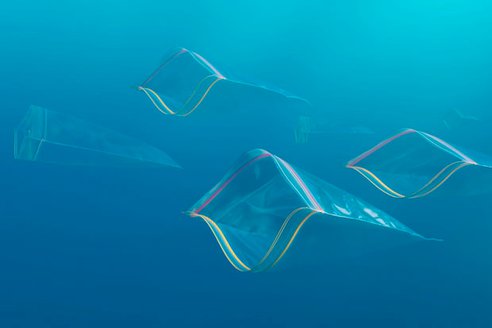We are a society built on consumption and our reliance on plastics is having a major impact on our environment, especially in our waterways and oceans. We’ve know about the floating islands of plastic, like the Great Pacific Garbage Patch, and other horror stories about plastics killing the sea life we so admire. Photographer Kim Preston has taken a hauntingly beautiful approach to a showcasing this problem. In her photographic series dubbed Plastic Pacific, she captures the plastic objects we use daily in fascinating underwater images that look like jellyfish fish, corals and other sealife our discarded plastics are killing each day.
[via Treehugger]
Have you ever witnessed a flash mob of dolphins? When you get a thousand dolphins together you have more than a PAR-TAY you have yourself a stampede or superpod. Seeing these in person are pretty rare and jaw-droppingly amazing and a boatload of people (literally a bunch of people out on a boat!) out for a whale-watching expedition last week got quite a surprise. Luckily someone capture and posted this video of the rare event off the coast of Dana Point in Southern California.
[via io9]
Winter brings exceptionally low tides along the California coast and can create some of the best opportunities to take advantage of tidepool viewing. The Birch Aquarium shared some wonderful images and information about local tidepools such as the ones at Dike Rock, a tidepooling site near the aquarium, that provided a unique opportunity to catch glimpses of the fascinating creatures roaming the California coastal water last month.
[via Birch Aquarium]
Sharks are often considered the great predators of the ocean, but some sharks do not give birth to live babies instead laying eggs that can take a few months to hatch. When they are developing in the egg, the growing bamboo shark embryos are susceptible to predators and a new research paper is showing that the growing sharks can actually sense and react to impending danger. When stimulated by electrical current mimicking predators, the baby sharks actually stop gill movement, wrap their tails around their bodies and hold still — for up to a minute. The new study is being published in PLoS ONE.
[via WIRED]
We were impressed with what Liquipel had to offer when we came across the company last February and were excited to see the company develop an ever better solution with the upcoming Liquipel 2.0. The latest version can take your electronic gadgets and apply a waterproof micro-coating that can achieve a liquid protection rating of at least IPX7 — that means full submersion in water up to 1m deep for 30 minutes. For all you klutzes out there, this is definitely a worthy investment.
[via Engadget]
A monstrously ginormous marine predator — 30 feet long with nasty teeth and most likely a temperament to boot — was discovered to have lurked in the Triassic seas covering Nevada more than 240 million years ago. Named Thalattoarchon saurophagis — lizard-eating sovereign of the sea — the icthyosaur was king of the food chain back in the day. This Old School oceanic predator had full of 5-inch-long teeth and existed just 8 million years after a mass extinction killed most of the planet’s marine fauna. This predator was reported in the Jan. 7 edition of Proceedings of the National Academy of Sciences.
[via WIRED]
For those of you with huge aquariums or plate-glass windows in your home and are too lazy to clean them manually, check out this new Winbot 7 from Ecovacs. Like a Roomba or RoboSnail, the Winbot 7 automatically moves along your window surface while cleaning and squeegeeing the glass. What makes this robot better than the rest is that it uses a vacuum seal to stick onto the window instead of a separate magnet piece that similar products use.
[via The Verge]





